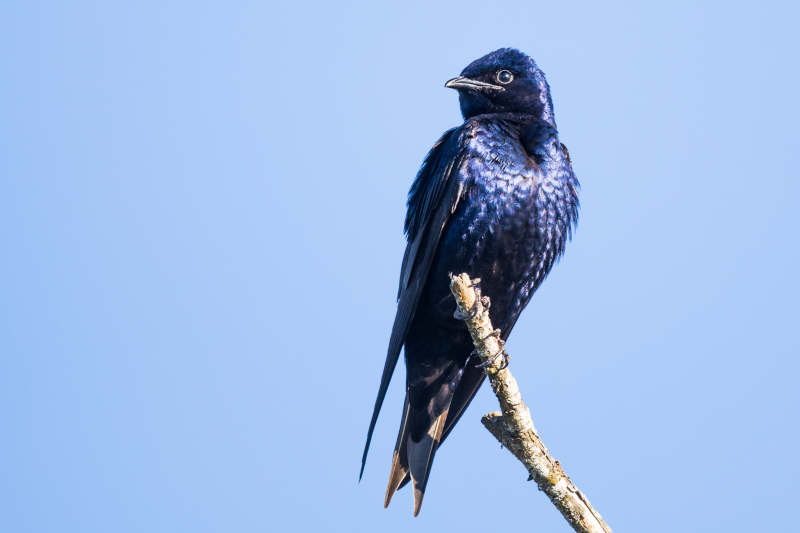When you get your first martins arriving at your purple martin house it is really exciting! You hope that they will return year after year. But, how long will they keep returning? What’s the actual lifespan of a purple martin?
Purple martins live on average to about four or five years old. A purple martin living past five years old is considered to be an old purple martin. The oldest purple martin record was nearly 14 years old.

In my purple martin colony, I believe most purple martins are probably returning for about five years. I have done a few things to help my martins survivability. Since they are migratory birds, I work hard to keep them healthy and strong. They have quite the journey to and from South America each year!
How Can I Add to the Survivability of my Purple Martins?
Keep in mind that the items listed below are optional. I do some of these, some of these I don’t but have heard of other landlords doing them to help the martins.
Option 1: Supplemental Feeding
In places like Oklahoma, the weather can change drastically. Particularly early in the season. The martins might arrive and the weather is in the 80’s. A day later, it might be down to 50 degrees. When the weather takes a turn for the worse, the insects aren’t flying. This means that the purple martins have a lack of food. It has been known that some purple martins can die during long stretches of poor weather.
What many purple martin landlords will do, is they will supplement the feeding with crickets and/or eggs. The downside is that they won’t do this naturally. You have to literally train them to eat these!
If you want to train your martins to this, you ahve to get pretty close to the martins. You use a plastic spoon, place a dead cricket on the spoon, pull it back and let go. The cricket is hurled into the air. You may need to do this a few times before one of the purple martins snatches out of the air. What you will notice though is once one purple martin figures it out, the others will follow!
The purple martins will find the crickets to be a natural part of their diet if you do this regularly. After a couple of weeks, you will be able to place the crickets on a feeder near the purple martin house and they will start eating them. The eggs come into play by combining eggs to the crickets. They will naturally begin to pick them up. It’s great for the hatchlings as well as the older martins. It adds calcium, makes their bones strong, and keeps them healthy!
Option 2: Predator Guards
The issue with most purple martins survivability is not that they get a disease and die. It’s not that they run out of food or water most of the time. The biggest issue is simply predators overtaking them.
Most purple martin colonies, especially those of decent size, will experience a few losses from predators from time to time. Owls will begin to find them, snakes will attempt to climb your pole, and raccoons will make their way up top and try to reach in for the hatchlings. You just hope that your protection is enough to keep the whole colony from being decimated!
I have written an entire article on how to protect your purple martins. The primary focus is on putting up some predator guards. There are some that are better than others, but it is a necessity if you want all of your martins to survive. Without it, you’re just waiting for something to come along and take out the majority, if not all of your colony.
The predator guards are generally geared towards owls, snakes, and raccoons. These are very dangerous predators. However, the starlings and house sparrows are a huge threat as well. These birds will attempt to take over the purple martin house, kill the hatchlings, and/or destroy eggs. I wrote an article that can help you identify some of these destructive birds.
Option 3: Do Regular Nest Checks
Your best chance of helping your purple martins before major problems arrive is to regularly check on your purple martins. This begins early in the season as the nests are first being built. You want to ensure that nothing else is taking over the purple martin units.
Some of the things you are looking for are things like bugs in the nests that might be harmful to the martins. When this happens, you generally will want to replace the nest with something cleaner. You want to do it pretty quickly, so this video is worth the watch on how to do it before making the attempt:
Also, there is a good chance that some eggs won’t hatch, or one or two of the young ones die. There is not always a good indicator as to why it happens, but when it does it is best to get rid of them from the nests. You don’t want anything, such as disease, to spread.
Is There a Way to Keep Track of Purple Martins?
If you wish to monitor the survivability of your purple martins, the only option is to place bands on your purple martins. The only way to do this is to trap your purple martins somehow. If you can block the doors and grab them before they escape, this is the best way. Another option is to purchase a bird trap. A bird trap like this one is fairly typical of purple martin landlords. These will catch all types of birds, typically used to catch the unwanted ones. However, at times it will also catch martins.
The best option is to purchase bands, such as these, place them on your purple martins. You will want to have some form of logging system to help you identify them year after year.
Another good option is to use a game camera to take several pictures of martins near your purple martin house. It may make it a little bit easier to monitor which purple martins have returned.
Conclusion
There isn’t always something you can do. Purple martins have quite a few natural predators. While they are in your care for a few months out of the year, the majority of their time will be spent away from you. A healthy purple martin has the best opportunity of survival as they may be faster than others, able to escape more quickly, able to defend themselves more readily. However, if a raccoon reaches into the purple martin house, there is little you can do as the landlord to help them combat these types of situations.
If you have had a lot of luck in having your purple martins live longer, I would love to hear how you have done that. Please reach out to me!
